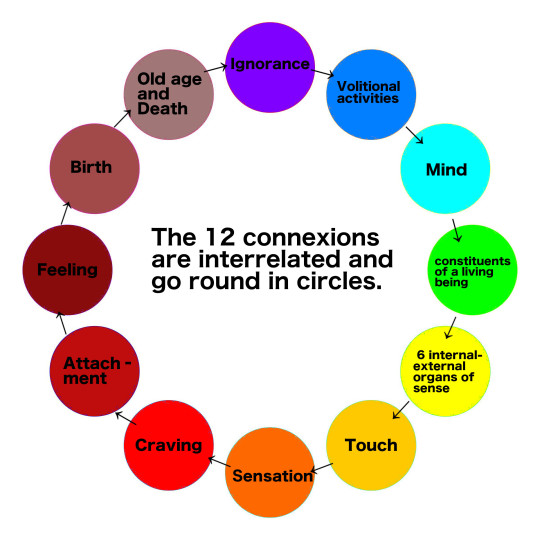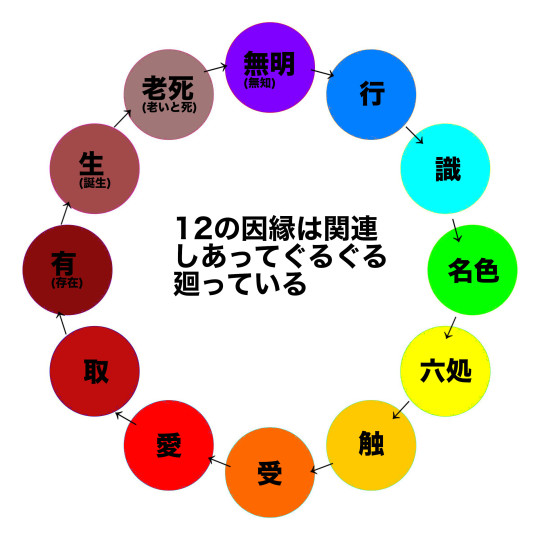#the 12 nidānas
Photo


The Quest for Buddhism (58)
Pratityasamutpada – the 12 links of conditioned arising - Part 3
From 7 to 12 causal branches continued as follows [See: 1 -6]:
7. Sensation – vedana is a Buddhist term referring to the sensing action of humans. It is the feeling of touch. The six senses come into contact with the six external sense organs through the six internal sense organs and sense them. Besides physical and physiological sensations such as 'hot' and 'painful', including those that are perceptually felt by the mind, such as suffering and pleasure. For example, feeling 'beautiful' when looking at nature.
8. Craving – trsna (tanha) is an important concept in Buddhism, referring to "thirst, desire, longing, greed", either physical or mental. The sanskrit word “trsna” is typically translated as craving, and is of three types: "craving for sensual pleasures", "craving for existence", and "craving for non-existence".Trsna is also mentioned in the 4 Sacred Truths, which state that it is the cause of suffering and that this causes living beings to repeat death and rebirth in the wheel of samsara.
9. Attachment– upadana means "fuel, material cause, substrate that is the source and means for keeping an active process energised". It is also an important Buddhist concept referring to "attachment, clinging, grasping". It is considered to be the result of trsna (craving), and is part of the dukkha (suffering, pain) dogma in Buddhism.
10. Feeling – bhava is the state of existence of a living being, the area of survival. It refers to the state in which sentient beings go through ‘trailokya’ in the cycle of samsara (reincarnation). Trailokya stands for the three realms that are the world of greed, the world of pure matter, free from desire(colour), and the world that transcends both desire and material conditions and dwells only in mental action (colourlessness).
11. Birth – Jati refers to the repeated existence of a person as a new life through samsara (reincarnation).
12. Old age and Death – Jaramarana stands for "old age" (jara) and "death" (marana). In Buddhism, jaramarana is associated with the inevitable decay and death-related suffering of all beings prior to their rebirth within samsara (cyclic existence).

仏教の探求 (58)
十二因縁 (じゅうにいんねん、梵: プラティチャサムトパーダ)・その3
七〜十二の支分は以下の通りに続く(参照: 1〜6):
7. 受 (じゅ、巴・梵: ヴェーダナー)とは、人間の感受作用を意味する仏教用語。触れたことを感じることである。六識が六根を通じ六境に接触し、まずそれを感受すること。肉体的、生理的に感じる「暑い」「痛い」などの感じの他にも、「苦しい」「快い」などの、心で知覚的に感じるものも含んでいる。例えば、自然を見て「美しい」と感じること。
8. 渇愛 (かつあい、梵: トリシュナー、巴: ターナー)は仏教における重要な概念で、肉体的または精神的な「渇き、欲望、あこがれ、貪欲」を意味する。サンスクリット語の「トリシュナー」は、通常、渇愛と訳され、「官能的快楽への渇愛」、「存在への渇愛」、「非存在への渇愛」の3種類がある。さらに渇愛は四諦 (したい、梵: チャトゥル・アーリヤ・サティヤ、4つの聖なる真理の意)にも記されており、それは苦の原因であり、これによって生けるものは輪廻の輪において死と再生を繰り返すとしている。
9. 取 (しゅ、梵・巴: ウパーダーナ)とは「燃料、物質的な原因、活動的なプロセスを活気づける源や手段である基質」を意味する。 また「執着、しがみつき、把握」を指す重要な仏教概念であり、トリシュナー (渇愛)の結果と考えられ、仏教のダッカ(苦痛) の教義の一部となっている。
10. 有 (う、梵: バーバ)とは、とは、生きものの生存状態、生存領域。三界を衆生が輪廻していく状態を指す。三界とは「欲望の世界(欲界)」「欲望を離れた清浄な物質の世界(色界)」そして「欲望も物質的条件も超越し、ただ精神作用にのみ住む世界(無色界)」の三つの世界のこと。
11. 生(しょう、梵:ジャーティ)とは、サンサーラによって新しい生命として、繰り返し存在しつづけることを指す (輪廻転生)。
12. 老死 (ろうし、梵:ジャラマラナ)とは、ジャラマラナとは「老い(ジャラ)」と「死(マラナ)」のこと。すべての生き物がサンサーラ(循環する存在)の中で生まれ変わる前に避けられない衰えと死に関連する苦しみのこと。
#pratityasamutpada#dvadasangika-pratityasamutpada#buddhism#buddha#reincarnation#samsara#the 12 nidānas#12 causal branches#nirvana#philosophy#nature#art#karma
149 notes
·
View notes
Text
12 Nidanas
The Twelve Nidānas(Pali/Sanskrit: निदान Nidāna "cause, foundation, source or origin") identify the origin of Dukkha (Suffering) to be in Avijja (ignorance). The twelve links in the chain of existence or causation; they are as follows:
1) Avidya, ignorance or unenlightenment;
2) Samskara, action, activity, conception, "dispositions";
3) Vijnana, consciousness;
4) Namarupa, name and form;
5) Sadayatana, the six sense organs, i.e., eye, ear, nose, tongue, body and mind;
6) Sparsa, contact, touch;
7) Vedana, sensation, feeling;
8) Trsna, thirst, desire, existing;
9) Upadana, laying hold of, grasping;
10) Bhava, being, existing;
11) Jati, birth;
12) Jaramarana, old age and death.

Article: The Twelve Nidanas as taught by the Buddha
22 notes
·
View notes
Text
Regarding the previous quote:
[Chapter XXIV. Thirst.,] 339. He whose thirst running towards pleasure is exceeding[ly] strong in the thirty-six channels, …
I believe ‘the thirty-six channels’ could refer to any number of kleshas (क्लेश):
• Mental hindrances:
“Monks, any desire-passion with regard to the eye is a defilement of the mind. Any desire-passion with regard to the ear... the nose... the tongue... the body... the intellect is a defilement of the mind. When, with regard to these six bases, the defilements of awareness are abandoned, then the mind is inclined to renunciation. The mind fostered by renunciation feels malleable for the direct knowing of those qualities with realizing.”
“[A]ll those Blessed Ones had first abandoned the five hindrances (sensual desire, anger, sloth-torpor, restlessness-worry, and doubt), defilements of the mind that weaken wisdom ….”
• Ten defilements and unwholesome roots
1. greed
2. hate
3. delusion
4. conceit
5. wrong views
6. doubt
7. torpor
8. restlessness
9. shamelessness
10. recklessness
• Twelve Nidānas
1. Ignorance - Not knowing suffering, not knowing the origination of suffering, not knowing the cessation of suffering, not knowing the way of practice leading to the cessation of suffering: this is called ignorance. It leads to action, or constructing activities.
2. Constructing activities - Any action, whether meritorious or harmful, and whether of body, speech or mind, creates karmic imprint on a being. This includes will (cetana) and planning. It leads to transmigratory consciousness.
3. Consciousness (rebirth consciousness) - These six are classes of consciousness: eye-consciousness, ear-consciousness, nose-consciousness, tongue-consciousness, body-consciousness, intellect-consciousness. This is called consciousness. As seen earlier, consciousness and the organ cannot function without each other.
4. Name-and-Form (mentality and corporeality) - Feeling, perception, intention, contact, and attention: This is called name (i.e. mentality or mind). The four great elements, and the body dependent on the four great elements: This is called form (i.e. corporeality or body).
5. Six-fold sense bases - The eyes, ears, nose, tongue, body and mind are the six sense media.
6. Contact - The coming together of the object, the sense medium and the consciousness of that sense medium is called contact.
7. Feeling (sensation) - Feeling or sensations are of six forms: vision, hearing, olfactory sensation, gustatory sensation, tactile sensation, and intellectual sensation (thought). In general, vedanā refers to the pleasant, unpleasant and/or neutral sensations that occur when our internal sense organs come into contact with external sense objects and the associated consciousness.
8. Craving - There are these six forms of cravings: cravings with respect to forms, sounds, smells, tastes, touch (massage, sex, pain), and ideas.
9. Clinging (attachment) - These four are clingings: sensual clinging, view clinging, practice clinging, and self clinging.
10. Becoming (karmic force, similar to volitional formations) - These three are becoming: sensual becoming, form becoming, formless becoming.
11. Birth (similar to rebirth consciousness) - Birth is any coming-to-be or coming-forth. It refers not just to birth at the beginning of a lifetime, but to birth as new person, acquisition of a new status or position etc.
12. All the sufferings.
• Three poisons
1. Delusion
2. Attachment
3. Aversion
• Five poisons (Mahayana school)
1. Ignorance
2. Attachment
3. Aversion
4. Pride
5. Envy
• Six root kleshas of the Abhidharma
1. Attachment
2. Anger
3. Ignorance
4. Pride/Conceit
5. Doubt
6. Wrong view/False view/Opinionatedness
• Mahaparinirvana Sutra (50 kleshas)
• Attachment
• Aversion
• Stupidity
• Jealousy
• Pride
• Heedlessness
• Haughtiness
• Ill-will
• Quarrelsomeness
• Wrong livelihood
• Deceit
• Consorting with immoral friends
• Attachment to pleasure
• Attachment to sleep
• Attachment to eating
• Attachment to yawning
• Excessive talking
• Uttering lies
• Thoughts of harm
…
• Two obscurations
1. The obscuration of conflicting emotions
2. The obscuration concerning the knowable
0 notes
Photo

The Quest for Buddhism (56)
Pratityasamutpada
Pratityasamutpada, or dvadasangika-pratityasamutpada is the twelve links or nidānas, a series of twelve conditions in Buddhism for the extinction of suffering by severing the roots of suffering in real life. It is one of the fundamental dogma of Buddhism.
They are direct internal causes that cause results and indirect causes that help them from outside.
The 'karma' philosophy, which is of great importance in Buddhism, does not recognise any independent entities, but means that they are established in relation to other things.
Pratityasamutpada (paticcasamupada), commonly translated as dependent origination, or dependent arising, is a key dogma in Buddhism shared by all schools of Buddhism. It states that all dharmas (phenomena) arise in dependence upon other dharmas: "if this exists, that exists; if this ceases to exist, that also ceases to exist". The basic principle is that all things (dharmas, phenomena, principles) arise in dependence upon other things.
The dogma includes depictions of the arising of suffering (anuloma- paticcasamupada, "with the grain", forward conditionality) and depictions of how the chain can be reversed (patiloma- paticcasamupada, "against the grain", reverse conditionality).
The traditional interpretation of these lists is that they describe the process of a sentient being's rebirth in samsara, and the resultant duhkha (suffering, pain, unsatisfactoriness), and they provide an analysis of rebirth and suffering that avoids positing an atman (unchanging self or eternal soul). The reversal of the causal chain is explained as leading to the cessation of rebirth (and thus, the cessation of suffering).
At that time, suffering is extinguished and samsara also ceases to exist because the root, ignorance (Skt. abidya), is extinguished.
[The 12 lists will be continued in the next article: click here]

仏教の探求 (56)
十二因縁 (じゅうにいんねん、梵: プラティチャサムトパーダ)
十二因縁 (じゅうにいんねん、梵: プラティチャサムトパーダ) あるいは、十二縁起 (じゅうにえんぎ、梵: デバーダサンギカ・プラティチャサムトパーダ)とは、仏教において、現実の人生の苦悩の根源を断つことによって苦悩を滅するための12の条件を系列化したもの。仏教の基本的な考えの一つである。
12の条件とは、結果を引き起こす直接の内的原因と、それを外から助ける間接的原因のことを指す。
仏教のきわめて重要な、いわゆる縁起思想は、いっさいのものに独立の実体を認めず、それらが他のものに縁(よ)って成立していることを意味する。
プラティヤサムトパーダ (巴: パーティッカサムパーダ)は、一般に縁起(えんぎ)と訳される、仏教の重要な教義であり、すべての仏教の宗派に共通するものである。すべてのダルマ(現象)は、他のダルマに依存して発生するというものである。「これが存在すればあれが存在し、こ��が消滅すればあれも消滅する」。すべてのもの(ダルマ、現象、原理)は、他のものに依存して生じるという基本原理である。
この教義には、苦しみが生じる描写(梵: アノロマ・パーティッカサムパーダ:「自然な形で」、順行条件づけ)と、その連鎖を逆転させる描写(梵: パティロマ・パーティッカサムパーダ:「自然の流れに逆らう」、逆行条件づけ)が含まれている。
これらの因縁は、衆生がサンサーラ(輪廻転生)によって生まれ変わる過程と、その結果生じるダーカ(苦しみ、痛み、満足できないこと)を釈明し、アートマン(不変の自己または永遠の魂)を仮定しない生まれ変わりと苦しみの分析を行っていると、伝統的に解釈されている。因果の連鎖が逆転することで、生まれ変わりが止まる(つまり苦しみが止まる)と説明されている。
その際には苦悩が消滅し、根源の無明 (梵: アビディヤ)が消滅しているため輪廻もなくなる。
[十二因縁の支分については次回に続く: ここをクリック]
#samsara#the 12 nidānas#pratityasamutpada#buddha#buddhism#reincarnation#dogma#philosophy#history#nature#art
125 notes
·
View notes
Photo


The Quest for Buddhism (57)
Pratityasamutpada – the 12 links of conditioned arising - Part 2 [Part 1]
The 12 causal branches are as follows:
1. Ignorance – avidya is a Buddhist term for ignorance. It refers to being dark to the truth. It is the root of suffering and is connected to the first causal circle, which is the beginning of repeated rebirths.
2. Volitional activities – samskara has two main meanings. In the first sense, samskara generally refers to 'conditioned matters' and 'phenomena caused by karmic connections'. In the second sense, samskara refers to karma as the will-action that gives rise to awareness, which is regarded as the cause of karmic phenomena. It refers to the impulse in the mind to do something, which arises from the state immediately before the impulse. By taking an action (karma), the desire to do the next action automatically appears.
3. Mind – vijnana is a Buddhist term meaning consciousness, life force, mind and insight. It refers to the mental action of distinguishing and perceiving objects of perception.
4. The constitutions of a living being – namarupa is an idiom formed by name (nāma) + form (rūpa, colour). In Buddhism, it is used to indicate the constitutive processes of a person, with nāma referring to the psychological elements of a person and rūpa referring to the physical elements, i.e. the 'mind and body', and nāma and rūpa are interdependent and inseparable. Therefore, namarupa refers to the individual. As one of the recurring sufferings, namarupa(name-colour) constitutes the 4th of the 12 causes and follows mind (vināna), which is the cause of the later 6 senses of ayatana.
5. The 6 Ayatana means the six sense organs, sense mediums and sense ranges. They are classified into ‘six internal sense organs’, and ‘six external sense organs’. Furthermore, in Buddhism and Indian philosophy, the sixth sense is listed as an addition to the five senses in the West. The sixth in Buddhism is 'mind', which refers to the internal sense organs that interact with sense objects, including sense impressions, emotions, perception and will.
6. Touch - sparsa means contact, sensation, touch, and so on. It is the act of a living being making contact with something. These are defined as originating from the three elements of the six internal sense organs,the six external sense organs, and mind(consciousness).
[7 to 12 continued in next article: click here]

仏教の探求 (57)
十二因縁 (じゅうにいんねん、梵: プラティチャサムトパーダ) あるいは、十二縁起 (じゅうにえんぎ、梵: デバーダサンギカ•プラティチャサムトパーダ)・その2(その1)
十二の支分は以下の通り:
1. 無明 (梵: アビディヤ)とは、仏教用語で、無知のこと。真理に暗いことをいう。無明は苦の根源であり、最初の因縁の輪に結びつき、繰り返す転生の始まりとなる。
2. 行 (ぎょう、梵: サンスカーラ、巴: サンカーラ)には主に二つの意味がある。一つ目の意味では、行 (ぎょう)は一般的に「条件づけられたものごと」「因縁によって起こる現象」をさす。二つ目の意味では、行 (ぎょう)は行蘊 (ぎょううん: 意識を生じる意志作用)として業(ごう、梵: カルマ)をさし、それらは縁起の原因とされる。心の中の「なにかをしたい」という衝動のことであり、その衝動はその直前の状態から生まれているのである。ある行動(カルマ, 業)を取ることで、その次の行動をしたいという欲求が自動的に現れるのである。
3. 識 (しき、梵: ヴィジュニャーナ、巴: ヴィニャーナ)とは、意識、生命力、心、洞察力との意味の仏教用語である。認識対象を区別して知覚する精神作用を言う。
4. 名色 (みょうしき、梵・巴: ナーマルーパ)とは、パーリ語およびサンスクリット語のナーマルーパに由来し、名前 (ナーマ)+姿 (ルーパ,色) による熟語である。仏教においては人の構成過程を示すために用いられており、ナーマは人の心理的要素を、ルーパは身体的要素、つまり「心と体」を指す。ナーマとルーパは互いに依存関係にあり、切り離すことができないとする。そのためナーマルーパは個人を指すものである。繰り返す苦の一つとして、名色は十二因縁の4番目を構成し、識(ヴィニャーナ)に続くものであり、後の六処の原因となる。
5. 六処(ろくしょ、梵・巴: 6 アーヤタナ)は、6つの感覚器、感覚媒体、感覚範囲を意味する。6つの内部感覚器六根 (ろっこん)と、6つの外部感覚器六境 (ろっきょう)に分類される。仏教およびインド哲学では、西洋での五感にプラスして第六感を挙げている。仏教における6つ目は「心」であり、感覚の印象、感情、知覚、意志などを含む感覚対象と、相互作用する内部感覚器官を指している。
6. 触 (しょく、巴: パッサ、梵: スパルサ)とは、接触、感覚、感触などといった意味である。生物が何かとコンタクトを取ることである。これらは六根 (ろっこん)、六境(ろっきょう)、識(意識)の3要素に由来するものと定義されている。
[7から12は次回へ続く:ここをクリック]
#pratityasamutpada#dvadasangika-pratityasamutpada#the 12 nidānas#karma#12 causal branches#buddhism#buddha#history#nature#art
115 notes
·
View notes